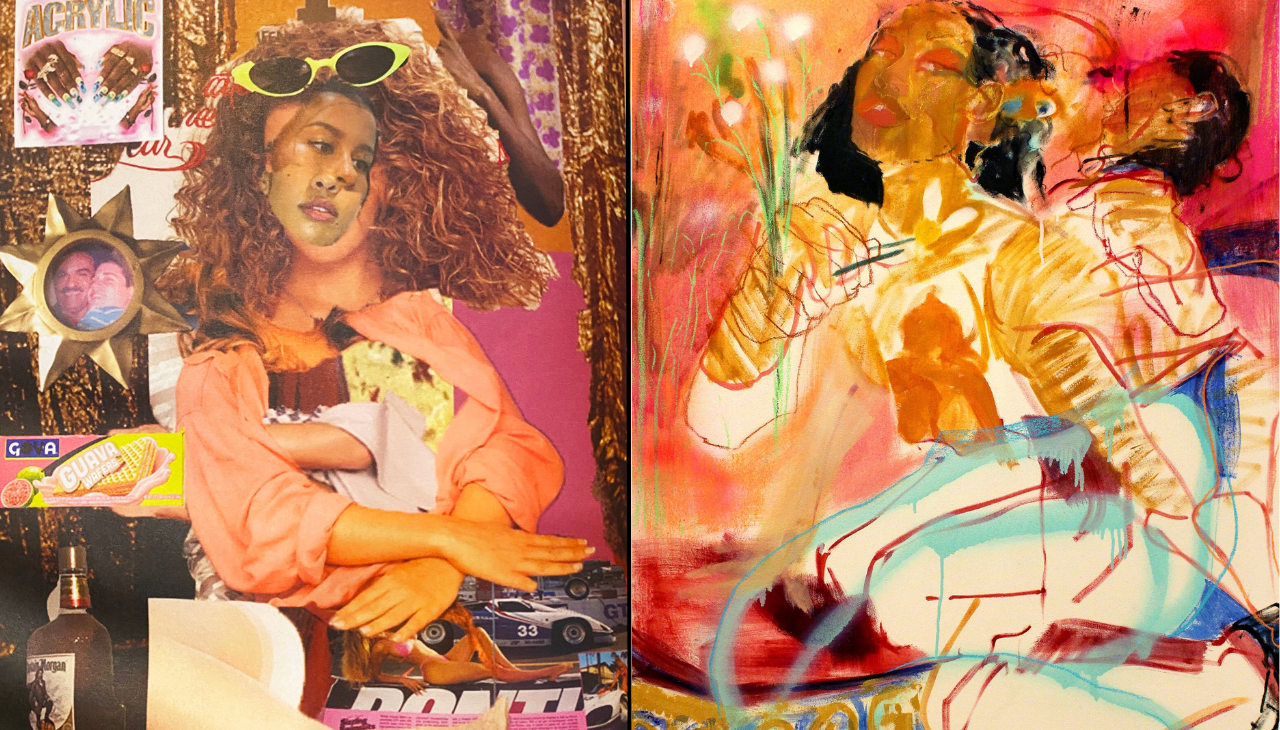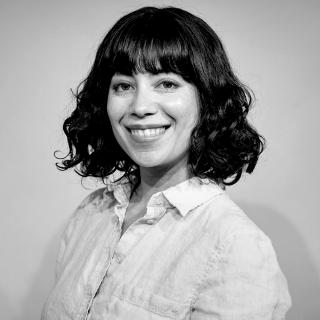
A conversation with artist Chloe Piñero
The young artist uses the collage technique to break the taboos of queer identity and rethink her relationship with Puerto Rico.
Chloe Piñero is an interdisciplinary artist and educator of Irish-Puerto Rican origin born in Philadelphia. She studied at The Philadelphia Creative and Performing Arts public high school and later received a Bachelor's degree in Fine Arts from Tyler School of Art and Architecture at Temple University.
Now 27, the artist excels at combining the techniques of collage and figurative art to analyze queerism, desire and sexuality. Chloe also identifies as queer and, as she explained to AL DÍA, although her identity was accepted by her immediate family, it still remains a taboo during her visits to Puerto Rico or even in the city of Philadelphia.
Through collage, the artist combines materials from thrift shops, social media, adult magazines and dollar stores to construct fantasy worlds that intertwine with her background and experiences as a Caribbean and queer person. The nostalgia for her ancestors also plays a starring role in her art, as well as exploring the canons of feminine beauty and the ways they are represented in the media.
Piñero combined each of these themes in her most recent exhibition "In Between and All at Once" at Philadelphia's Magic Garden. With a total of 18 pieces, the artist worked with digital collage prints, mixed media paintings and a vinyl installation.
As part of the exhibit, the artist added to her pieces the most cherished memories of her childhood and her attachment to the stories her family shared with her about Puerto Rico. Hence the Goya brand labels, the plátano leaves, the chopped soursop and the box of Newport cigarettes her mother smoked.

The exhibition was on view from December 9, 2022 through February 26, 2023.
To learn more about her creative process and artistic background, AL DÍA spoke exclusively with the artist. We discussed gender identity, collage technique and the representation of Latinx people in the arts. Here our conversation with Chloe Piñero:
The winning technique in your most recent exhibition is the combination of collage and painting. As an artist, why did you decide to use these techniques to address issues such as feminism, queer and nostalgia as a Puerto Rican descendant?
For me collage is a process that allows the multiplicity of identity and experience to exist together. While my queerness is accepted in my immediate family it’s not really spoken about and still feels taboo in many ways when I’m on the island, and even here in Philly sometimes. Being from a mixed Irish-Puerto Rican background, and being queer, sometimes I find myself not being able to fully be all of these things, and find myself having to be less of something in different spaces or company. So collage becomes this a place or world building where all of these experiences can exist fully together- representing how things exist within myself and my mind. The title “In Between and All at Once” references this idea of having a layered identity and sort of straddling worlds.
I also think using imagery and material from my upbringing and native home of Philadelphia, and my ancestral home of Puerto Rico (PR) allows me to preserve memories and moments in time. Using imagery from PR and family objects in my work allows me to spend more time with family and childhood in a way. Growing up my connection to Puerto Rico was through family here in Philly, but also through objects from the island in my home and family photographs.
The bodies in my work are an exploration of the feminine figure and the ways in which these bodies are represented in media. I pull a lot of imagery from vintage adult and Glamour magazines to explore nostalgia and build from conventional beauty standards to make almost monstrous figures made from many disparate parts. Through this process the bodies become almost “nonfunctional” and broken. I’m interested in how the depicting of the figure in a fragmented way can blend the boundaries of the body with the environment, and into other figures if there's more than one depicted. I think what might be considered feminist about the work is using collage to disrupt the male centered imagery that we are fed into my own images which are built through my perspective as a woman and through a lens of queer desire.
How did you come up with the idea of turning the artwork you have been doing for years into an exhibition that was divided into three parts: daytime, night-time and dream night space/digital space?
I think the space is usually set up into these three sections. I often think about the work I make being in this fantasy world that shifts between a “daydream” space and a nightlife/actual dream world.
I wanted there to be this journey for the viewer from day (in the front room) into a night/dream space (in the 2nd room). The 3rd room takes on this sort of fragmented digital space which for me references my early experiences with the internet. It’s a space where time collapses and different places and moments exist at once- which is something I think a lot about when making the digital collage work. I see collage as a process where all parts of myself/ my identity can exist in the worlds I create within the work.
RELATED CONTENT
I like that the 3rd room simultaneously references internet space and the nostalgia of a childhood bedroom. Growing up, our bedrooms are an extension of our personal expression and become a sort of personal haven which is so similar to how the internet functions with finding like-minded people and communities.
What do you think about the hypersexualization of women over time? Do you think there has been an advance or rather the platforms have changed and now what used to be shown in magazines is shown in social media?
I think that representation of women in tv and movies has significantly changed since my childhood. I see so many different and nuanced representations of gender, sexuality, race, and culture within women or non binary characters on screen. I think that social media has sort of taken on the perpetuation of unrealistic beauty standards and hypersexualization with what previously existed in tv or movies –probably because of how algorithms work, influencer culture, and who is running these platforms–. I will say that there are also so many people on Instagram who actively defy these norms/standards and are great advocates for fluid gender expression and body positivity.
What challenge, if any, do queer and Latinx people face in the art world?
I can’t speak for everyone's experience. But I do think there have been challenges of creating spaces for Latinx artists in academic and art institutions and in the art market because American Art and Latin American Art have historically been viewed as being two separate marketable categories. It’s unfortunate that what work is deemed most marketable also dictates lanes of opportunity. I think it is also difficult for people to wrap their heads around how varied and nuanced the experiences of Latinx people/artists are and how this is a very broad identifier for a large group of people with differing geographical backgrounds and colonized histories layered within American experience. Author and NYU professor Arlene Dávila has written a book titled Latinx Art: Artists, Markets, and Politics which highlights some of these issues. She is also the founding director of the Latinx Project at NYU which does an amazing job at bridging some of these gaps and being an advocate for Latinx artists. As far as being queer, I think this is a really common experience and identity in the art world and because it spans race and culture there is definitely more leverage that queer people can have in carving out space depending on other parts of their identity. It has been my experience that like in the Latinx arts community, queer artists tend to uplift each other as well.
I know you used thrift shop articles, magazines and social media for your exhibition, how is the process of selecting the resources you are going to use? Do you paint first and then add the collage or vice versa?
I’ve always been someone who is absorbed in my environment and I’m constantly in the process of archiving and documenting in my everyday life. Whether that's through taking photos on my phone, screenshotting from social media, or having specific memories and using Google image to find images of objects or places. I also will find materials or objects from dollar, thrift, and hardware stores that are familiar from my childhood. Typically I’ll create a digital collage in photoshop to use as a foundation for a larger painting, then I’ll loosely block out a composition or the image with oil paint. Usually I’ll stray away from the original collage image as the painting develops a story or narrative. As I’m painting with different materials I start to glue in found images or found objects to complete the figures or environment, which becomes a way to complete the image and add to the story I'm creating in the work. It’s definitely a multi step process of going back and forth between the painting, drawing, and the embedded materials.
Tell me a little about your relationship with Puerto Rico… what part of Puerto Rico is your family from and when did they come to Philadelphia?
My grandfather came to Philadelphia in the late 1950’s to find work, he married my grandmother and had 5 kids, which he left when he returned to PR around 1965. Growing up my father had a complicated relationship with my abuelo, so it wasn’t until I was older that I finally was able to visit the island. When I went it felt like magic and like what I had stored deeply in my genetics and subconscious was finally tangible. It’s a hard feeling to explain but it’s like a feeling of becoming whole or complete or of being home. My father moved to PR in 2018 to be closer to family and my grandfather. Since then I have been visiting more frequently -maybe twice a year if I can.
My grandfather is originally from Ceiba and still lives there today. I have aunts and cousins who live in Fajardo, and also family members who travel and live back and forth between the island and the United States.
What are your future plans as an artist?
I plan to continue to have shows and develop my practice alongside my education work. I would love to keep exploring installations with cut out imagery and I have a few more book ideas that I’m brainstorming at the moment. I hope to do more residencies and I’m considering grad school at some point in the near future.
I'm currently a College/Postgraduate Apprentice at The Fabric Workshop and Museum. The program has been so exciting and encouraging to be a part of!











LEAVE A COMMENT:
Join the discussion! Leave a comment.